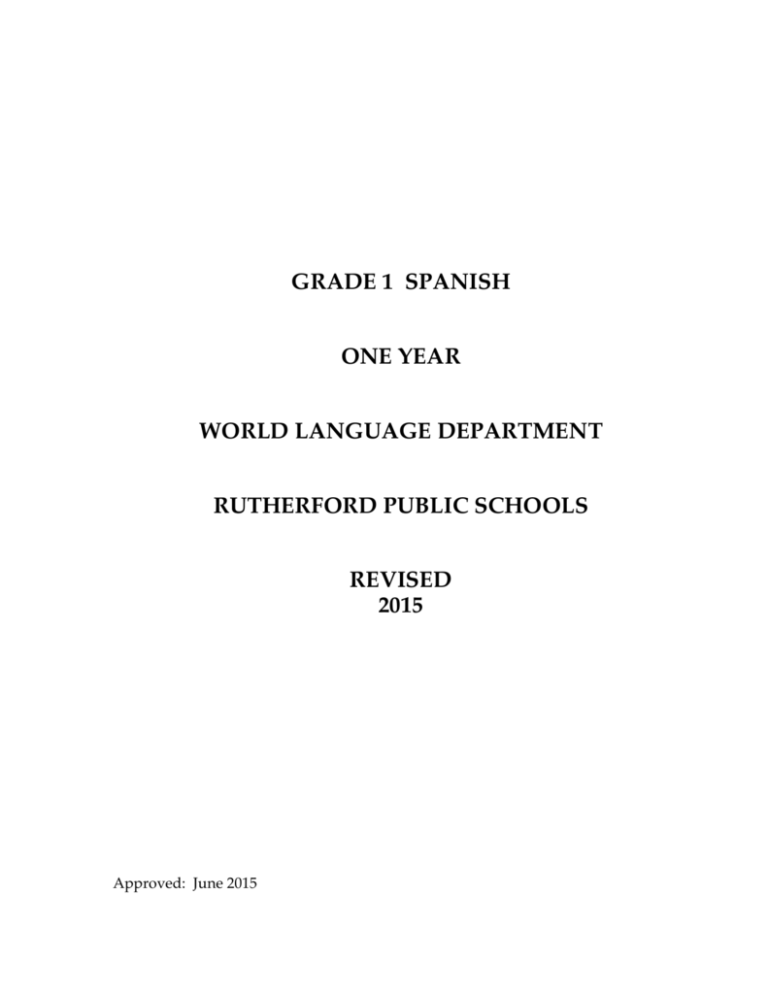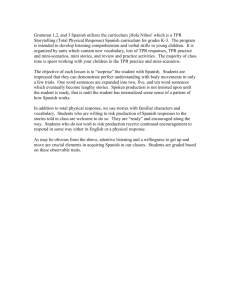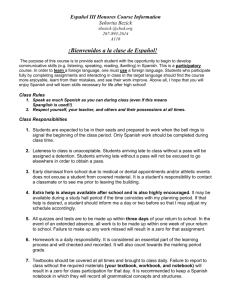Spanish (Elementary) Grade 1
advertisement

GRADE 1 SPANISH ONE YEAR WORLD LANGUAGE DEPARTMENT RUTHERFORD PUBLIC SCHOOLS REVISED 2015 Approved: June 2015 RUTHERFORD SCHOOL DISTRICT Rutherford, New Jersey SPANISH - GRADE 1 2015 I. Statement of Purpose Within the scope of the second-year Spanish program, the focus is to provide the students with a foundation in the interpersonal communicative skills of listening and speaking. How language and culture interact and promote intercultural understanding will also be continued. Students’ language learning becomes a positive, non-threatening process, similar to the way children acquire their first language. II. Objectives A. NJ Core Curriculum Standards for World Languages (2014) For a complete copy of the NJ Core Curriculum Content Standards for World Languages, please visit the following website: http://www.nj.gov/education/cccs/2014/wl/ Standard 7.1 World Languages: All students will be able to use a world language in addition to English to engage in meaningful conversation, to understand and interpret spoken and written language, and to present information, concepts, and ideas, while also gaining an understanding of the perspectives of other cultures. Through language study, they will make connections with other content areas, compare the language and culture studied with their own, and participate in home and global communities. 2 B. Skills This course will emphasize the language skills of listening and speaking. C. 1. Speaking a. modeling utterances after the teacher, CD’s and singing b. answering simple questions 2. Listening a. listening to the teacher b. listening to CD’s c. hearing other students 3. Reading a. flash cards 4. Writing a. games and puzzles 5. Culture a. films/DVD’s b. pictures c. tapes, CD’s and SMART Board d. stories e. holidays and events f. people Content These lists show only those items that the children practice, not the many others that the teacher introduces for enrichment and for the development of children’s listening and comprehension skills. The English equivalents are what an English-speaking person would ordinarily say in a comparable situation. They are not word-for-word translations. The topics listed below are introduced in kindergarten and grade 1. Within each topic, words and expressions are usually in alphabetical order, and divided into vocabulary items and functional expressions, usually in the form of questions and answers. 1. Greetings, farewells, introductions a. Vocabulary Adiós. Buenos días Buenas tardes Good-bye. Good morning Good afternoon 3 Buenas noches Hola ¿Cómo estás? Estoy bien. Estoy mal. Estoy así-así. Good evening, Good night Hello/Hi How are you? I am fine. I am not well. I am so-so. b. Questions regarding names ¿Cómo te llamas (tú)? What is your name? Me llamo __________. My name is __________. 2. Classroom people and objects a. Vocabulary la bandera el calendario el escritorio el globo el lápiz el libro la maestra el maestro el mapa la mesa el papel la pizarra la regla el reloj la silla la tiza b. Questions regarding an object ¿Qué es esto? 3. flag calendar desk globe pencil book (female) teacher (male) teacher map table paper chalkboard ruler clock chair chalk What is this? Colors a. Vocabulary amarillo anaranjado azul blanco café gris morado yellow orange blue white brown gray purple 4 negro rojo rosado verde 4. Days of the week a. Vocabulary lunes martes miércoles jueves viernes sábado domingo 5. mouth head face nose eyes shoulder feet Seasons a. Vocabulary el inverno la primavera el verano el otõno 7. Monday Tuesday Wednesday Thursday Friday Saturday Sunday Parts of the body a. Vocabulary la boca la cabeza la cara la nariz los ojos los hombros los pies 6. black red pink green winter spring summer fall Months a. Vocabulary enero febrero marzo abril mayo junio julio agosto septiembre octobre noviembre January February March April May June July August September October November 5 diciembre 8. Numbers 1-10 a. Vocabulary uno dos tres cuatro cinco seis siete ocho nueve diez once doce trece catorce quince dieciséis diecisiete dieciocho diecinueve veinte 9. December one two three four five six seven eight nine ten eleven twelve thirteen fourteen fifteen sixteen seventeen eighteen nineteen twenty Miscellaneous a. Vocabulary el español No Sí III. Methods of Assessment A. Student Assessment Spanish (language) No Yes Assessments are a continual process. Teachers may use a rubric for holistic assessment for each child and/or more formal assessments. Assessment in second-language learning needs to operate at a number of different levels, because of the many layers of skills and proficiencies that are being acquired, and that thus need to be assessed and evaluated. The types of assessment fall into three major categories. 6 1. 2. 3. 4. B. Proficiency Assessment a. the emphasis is on performances, what students can do with the language and to what extent they can transfer the language into real-life settings. Achievement Assessment a. it requires students to demonstrate retention of previously learned content material, vocabulary and structure, for example. Pro-achievement Assessment a. it is a combination of both proficiency and achievement testing. b. it asks students to demonstrate what they know in a meaningful context. Assessment Strategies a. formal assessment b. informal assessment c. one-on-one assessment d. group assessment e. benchmark assessments Curriculum/Teacher Assessment Since curriculum development is an on-going process, the teachers will provide the world language department supervisor with suggestions for changes and updates as this course requires. IV. Grouping A. V. VI. The students in this course are heterogeneously grouped according to grade level. Articulation/Scope and Sequence/Time Frame A. This course is the second level in the sequence of the Spanish elementary school program. B. It is a full-year course that integrates learning Spanish simultaneously within the regular curriculum. Resources A. Speakers 1. Speakers may be invited to address the classes on cultural topics. 7 a. b. B. VII. The N.J. State Artists in Residence Program Parents References 1. American Council on the Teaching of Foreign Languages, (1996) Standards for Foreign Language Learning; Preparing for the 21st Century. Yonkers, NY: ACTFL 2. ¡Hola!: ¡Viva el español!, Annotated Teacher’s Edition, (2005) Ava Dellisle-Chatterjee, Linda West Tibensky and Abraham Martíez-Cruz, National Textbook Company. 3. New Jersey State Department of Education, (2014) Core Curriculum Content Standards. Trenton, NJ. 4. New Jersey State Department of Education, (1999) World Language Curriculum Framework, Trenton, NJ. 5. Teach Them Spanish!, (2001), Instructional Fair 6. Beginning Spanish for Young Children, (2004), Carson Dellosa 7. Español Para Ti, (2000) National Textbook Company, Contemporary Publishing Group, Inc. Technology http://www.state.nj.us/education/cccs/2014/tech/ 8.1 Educational Technology: All students will use digital tools to access, manage, evaluate, and synthesize information in order to solve problems individually and collaboratively and to create and communicate knowledge. A. Technology Operations and Concepts 8.1.2.A.1 B. Creativity and Innovation 8.1.2.B.1 C. Communication and Collaboration 8.1.2.C.1 D. Digital Citizenship 8.1.2.D.1 E. Research and Information Literacy 8.1.2.E.1 F. Critical Thinking, Problem Solving, and Decision-Making 8.1.2.F.1 8.2 Technology Education, Engineering, and Design: All students will develop an understanding of the nature and impact of technology, engineering, technological design, and the designed world, as they relate to the individual, global society, and the environment. A. Nature of Technology: Creativity and Innovation 8.2.2.A.1 B. Design: Critical Thinking, Problem Solving, and Decision-Making 8.2.2.B.1 C. Technological Citizenship, Ethics, and Society 8.2.2.C.1 D. Research and Information Fluency 8.2.2.D.1 E. Communication and Collaboration 8.2.2.E.1 F. Resources for a Technological World 8.2.2.F.1 G. The Designed World 8.2.2.G.1 8 VIII. Methodologies Realizing that each student has a unique way of learning, it is important to vary teaching methods. Listed below are several different methods, which may be used in combination. A. Inductive Approach A strategy that enables classroom instruction to be conducted in the target language, an inductive approach to grammar teaches concrete vocabulary through pictures and objects, while abstract vocabulary is taught by association of ideas. B. Natural Approach A strategy that promotes communicative proficiency by providing realworld, authentic experiences and language experiences within meaningful contexts. C. Password/Language Ladders A strategy in which students learn to speak sentences or phrases (“passwords”) that are associated with desired activities. D. Gouin Series A strategy in which students learn to use short sentences or phrases to describe a logical sequence of actions that take place in a specific context that is familiar to the student. E. Dialogue Journals A strategy in which students use journals as a way to hold private conversations in the target language with the teacher. Dialogue journals are vehicles for sharing ideas and receiving feedback in the target language. The dialogue can be conducted by e-mail where it is available. F. Total Physical Response (TPR) A strategy in which students respond with physical activity to an increasingly complex set of commands. The students’ response of physical activity signals their comprehension of the command. This is ideally suited for beginning foreign language students, but can be adopted and made more complex for higher-level students. G. TPR Storytelling Based on the Natural approach, TPR Storytelling combines the effectiveness of TPR with the power of storytelling. TPR Storytelling teaches students to use the vocabulary they have learned in the context of entertaining, content-rich stories. 9 Language production goes beyond the imperative into the narrative and descriptive modes. H. Interviews A strategy for gathering information and reporting. I. Cloze Open-ended strategy in which a selected word or phrase is eliminated from a written or oral sentence or paragraph. J. Continuums A strategy used to indicate the relationship among words or phases. K. Interactive Language Tasks A strategy in which at least two students work together to accomplish a meaningful target language activity. L. Cultural Presentations A strategy for creating an exhibit that is focused on aspects of the target culture. M. The Learning Cycle A sequence of lessons designed to have students engage in exploratory investigations, construct language and culture concepts to their own lives. N. Read and Retell An all-purpose strategy that involves students retelling a passage in the target language as they remember it. O. Literature, History and Storytelling A strategy in which the culture and history of another country is brought to life through literature, folktales, and folk songs. P. Cooperative Learning A strategy in which students work together in small groups to achieve a common goal, while communicating in the target language. Cooperative learning involves more than simply putting students into work or study groups. Teachers promote individual responsibility and positive group interdependence by making sure that each group member is responsible for a given task. Cooperative learning can be enhanced when group members have diverse abilities and backgrounds. Q. Brainstorming A strategy for eliciting ideas from a group and communicating them in the target language in oral or written form. 10 IX. R. Problem Solving A learning strategy in which students apply knowledge to solve problems. S. Reflective Thinking A strategy in which students reflect on what was learned after a lesson is finished, either orally or in written form. T. Field Experience A planned learning experience for students to observe, study, and participate in expressions of the target culture(s) in a setting off the school grounds, using the community as a laboratory. U. Free Writing A strategy for encouraging students to express ideas by writing in the target language. V. Free Reading A strategy for encouraging students to read in the target language. Suggested Activities Incorporating a variety of activities to accommodate the learning styles of all students is a necessary requirement. A. B. C. D. E. F. G. H. Linguistic activities Logical-mathematical Spatial Bodily-kinestic Musical Interpersonal Intrapersonal Naturalist - physical world X. Interdisciplinary Connections As the students progress through the levels of the Spanish program, so too will the interdisciplinary content progress. They will gain an insight that the study of Spanish offers much to their overall education. A. Content-Based Topics 1. Art a. Draw with various media b. Cut and paste 2. Language Arts a. Demonstrate characteristics of a good listener b. Follow a one-step oral direction 11 c. Compare and contrast sounds d. Recall presented materials e. Identify a purpose for listening f. Listen for a variety of purposes g. Activate prior knowledge h. Listen to various forms of music i. Describe objects and pictures j. Communicate in complete sentences k. Obtain information by asking questions l. Participate in various forms of oral communication m. Interact verbally in informal situations n. Make introductions XI. 3. Mathematics a. Sort objects in a variety of ways b. Recognize, develop patterns c. Reason, connect mathematical understandings d. Observe and compare by measurable attributes e. Count objects f. Represent quantities 4. Music a. Explore differences between singing and speaking b. Sing songs in limited range 5. Reading a. Identify words 6. Science a. Observe weather conditions 7. Social Studies a. Identify self by name and birthday b. Be introduced to other people and places Differentiating Instruction for Students with Special Needs: Students with Disabilities, English Language Learners, and Gifted & Talented Students Differentiating instruction is a flexible process that includes the planning and design of Instruction, how that instruction is delivered, and how student progress is measured. Teachers recognize that students can learn in multiple ways as they celebrate students’ prior knowledge. By providing appropriately challenging learning, teachers can maximize success for all students. Examples of Strategies and Practices that Support: 12 Students with Disabilities • Use of visual and multi-sensory formats • Use of assisted technology • Use of prompts • Modification of content and student products • Testing accommodations • Authentic assessments Gifted & Talented Students • Adjusting the pace of lessons • Curriculum compacting • Inquiry-based instruction • Independent study • Higher-order thinking skills • Interest-based content • Student-driven instruction • Real-world problems and scenarios English Language Learners • Pre-teaching of vocabulary and concepts • Visual learning, including graphic organizers • Use of cognates to increase comprehension • Teacher modeling • Pairing students with beginning English language skills with students who have more advanced English language skills 13 • Scaffolding •word walls •sentence frames •think-pair-share •cooperative learning groups •teacher think- aloud XII. 21st Century Life And Careers Career Ready Practices describe the career-ready skills that all educators in all content areas should seek to develop in their students. They are practices that have been linked to increase college, career, and life success. Career Ready Practices should be taught and reinforced in all career exploration and preparation programs with increasingly higher levels of complexity and expectation as a student advances through a program of study. http://www.state.nj.us/education/cccs/2014/career/ 9.1 PERSONAL FINANCIAL LITERACY B. MONEY MANAGEMENT 9.1.4.B.1, 9.1.4.B.2, 9.1.4.B.3, 9.1.4.B.4, 9.1.4.B.5 C. CREDIT AND DEBT MANAGEMENT 9.1.4.C.1, 9.1.4.C.2, 9.1.4.C.3, 9.1.4.C.4, 9.1.4.C.5, 9.1.4.C.6 D. PLANNING, SAVING, AND INVESTING 9.1.4.D.1, 9.1.4.D.2, 9.1.4.D.3 E. BECOMING A CRITICAL CONSUMER 9.1.4.E.1, 9.1.4.E.2 F. CIVIC FINANCIAL RESPONSIBILITY 9.1.4.F.1, 9.1.4.F.2 9.2 CAREER AWARENESS, EXPLORATION, AND PREPARATION A: CAREER AWARENESS 9.2.4.A.1, 9.2.4.A.2, 9.2.4.A.3, 9.2.4.A.4 XIII. Professional Development As per the PDP/150 hours statement: the teacher will continue to improve expertise through participation in a variety of professional development opportunities. 14 15 Curriculum Map—Grade 1 Spanish Class Grade 1 Spanish September Greetings and polite phrases October Color words November Numbers one to ten December Days of the week January Months of the year (Environmental labels will be placed around the classroom.) February How are you? Questions and answers March Body parts “Cara & Cabeza Hombre” song April Seasons May Numbers 11-20 June Words for days of the week Numbers 1-10







